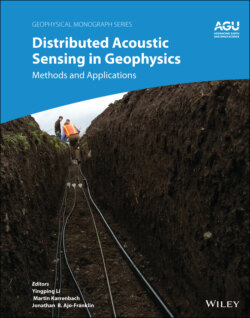Читать книгу Distributed Acoustic Sensing in Geophysics - Группа авторов - Страница 19
1.1.3. DAS Optical Phase Recovery
ОглавлениеThe randomness of the COTDR signal can be reduced through proper control of the external interferometer phase shift ψ0, which can be achieved in many ways. All these methods are based on the fact that COTDR intensity is random in distance but will vary harmonically depending on the phase, as follows from Equation 1.1 (see Figure 1.6). So, phase control can reveal phase information regardless of the random nature of the signal.
We will start our phase analysis with a simple, although not very practical, approach, where the phase shift ψ0 is locked onto a fringe sin(ψ0 + Φ) ≡ 1. Such an approach was used earlier to analyze the spatial resolution in phase microscopy (Rea et al., 1996). Then Equations 1.8 and 1.9 can be averaged over an ensemble of delta correlated backscattering coefficients 〈r(u)r(w)〉 = ρ2δ(u − w) as:
Equation 1.10 demonstrates that the sign of Doppler shift can be measured by DAS with proper phase control. The same data can be extracted directly from phase information, as is clear from Equation 1.11.
So far, we have analyzed the short pulse case, where the pulsewidth is significantly smaller than the external interferometer delay. In reality, such pulses cannot deliver significant optical power, which is necessary for precise measurements. Fortunately, Equations 1.10–1.11 can be generalized for a nonzero length optical pulse e(z) directly from Equation 1.5 in the same way that an optical incoherent image was obtained in Goodman (2005) using correlation averaging 〈(a ⊗ r1)(a ⊗ r2)〉 = 〈a2〉 ⊗ 〈r1r2〉. This expression is valid for an uncorrelated field, generated by random reflection points 〈r1(z1)r2(z2)〉 = δ(z1 − z2). This calculation confirms that Equation 1.11 remains the same, as it represents averaging over different harmonic signals, but Equation 1.10 will be reshaped to:
Equation 1.11 gives us the possibility to introduce a dimensionless signal as a phase change over a repetition or sampling frequency FS period A(z) = FS · ∂Φ/∂t, and so the DAS output A(z) can be represented for pulsewidth τ(z) = e(z)2 from Equations 1.3, 1.10, and 1.11 as:
Figure 1.6 Intensity changes are irregular along distance but harmonic along phase shift axis.
In Equation 1.14, the elongation corresponding to ΔΦ = 1 rad is A0 = 115nm, calculated for λ = 1550, neff = 1.468 and Kε = 0.73, which has been measured for conventional fiber (Kreger et al., 2006). The DAS signal is a convolution of pulse shape (as is typical for OTDR‐type distributed sensors) with a measured field, which is the spatial difference in fiber elongation speed of points separated by a gauge length.
Phase measurements can be made in a more practical way than locking the interferometer onto a fringe by using intensity trace Ij(z, t) j = 1, 2, ..P from P multiple interferometers with different phase shifts. Such data can be collected consequentially in P optical pulses, but it reduces sensor bandwidth by P times. Alternatively, the information can be collected for one pulse using a multi‐output optical component, such as a 3×3 coupler. In the general case, the phase shift Φ(z, t) can be represented (Todd, 2011) via the arctangent function ATAN of the ratio of imaginary Im Z to real part Re Z of linear combinations of intensities:
(1.16)
where V is the visibility given by the ratio of peak‐to‐peak intensity variation to average intensity of the interference signal. In particular, for a symmetrical 3×3 coupler, and Re Z = I1 − 2I2 + I3. An additional modification of Equation 1.15 including phase unwrapping will be discussed in the next section. It is interesting to mention that a heterodyne approach (Hartog et al., 2013) can also use quadrature measurements similar to Equation 1.15, but in that case phase diversity is realized in the OTDR time/distance scale, which can affect spatial resolution. Also, we can mention that the interferometer approach does not need a highly coherent laser, as the optical lengths of interfering rays are nearly compensated (Posey et al., 2000).
The theoretical expression for DAS resolution (Equation 1.13) was obtained from analysis of an interferometer locked onto a fringe, and it is necessary to test how this is applicable to practical phase measurement algorithms. Also, Equation 1.13 contains averaging over a statistical ensemble, and it is important to understand what it means in a real application. To answer the questions, we have compared theoretical values with a simulation based on a 3×3 coupler setup for 100 different random Rayleigh scattering patterns for a wide variety of parameters and found good comparison after averaging. To illustrate this analysis, three optical pulsewidth settings were used for interferometer delay (gauge length) of L0 = 10m and a ground velocity zone of 40 m (Figure 1.7a–c).
All traces (Figure 1.7a–c) correspond to strain measurements rather than to ground velocity profile measurements. If the pulsewidth is small, τ = 10ns, then averaging is not important, and the correspondence between different phase recovery algorithms are clear (Figure 1.7a). For a reasonable pulsewidth, τ = 50ns, only averaged simulation results correspond to theory (Figure 1.7b). If pulsewidth τ = 100ns becomes equal to L0 = 10m in the OTDR scale, then averaging is critical, but after it 100 times averaging correspondence is good (Figure 1.7c). It is important to mention that this simulation did not include photodetector noise, and noise‐like performance in Figure 1.7c can be explained by the COTDR signal, which will be overlaid on the DAS signal with nonzero pulsewidth. This is a natural limit for increasing SNR by extending pulsewidth; we have a compromise between SNR and signal quality at around L0 = 2τ. Finally, we can expect that the theoretical expression (Equation 1.13) can be used for spatial resolution analysis for different phase recovery algorithms after a proper averaging.
Figure 1.7 Comparison of DAS theoretical response (Equation 1.13) with simulation for a 3 × 3 coupler.
